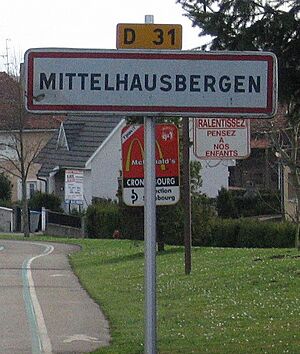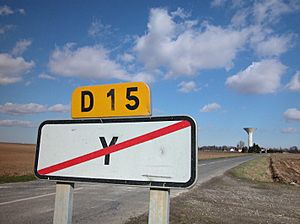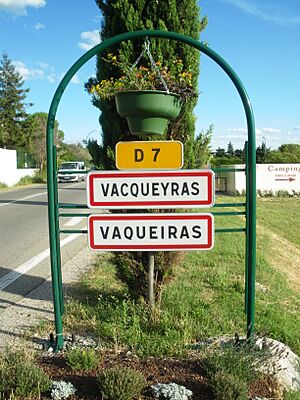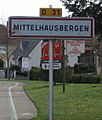Communes of France facts for kids
Quick facts for kids Communes of France |
|
|---|---|
 |
|
| Category | Municipality |
| Location | France |
| Found in | Departments |
| Number | 34,965 (List) (as of January 2021) |
| Populations | 1 (Rochefourchat) – 2,175,601 (Paris) |
| Areas | 0.04 km2 (Castelmoron-d'Albret) – 18,360 km2 (Maripasoula) |
| Government | Municipal council |
A commune (pronounced "koh-MYOON") is a special type of local area in France. Think of it like a town, city, or even a small village. It's the smallest way France divides its land for managing things.
French communes are similar to towns or small cities in other countries. For example, they are like "municipalities" in the United States or "Gemeinden" in Germany. Each commune has its own local government. This government helps manage the people and land in that area. Communes are the fourth level of administrative divisions in France.
Communes come in all shapes and sizes! Some are huge cities with millions of people, like Paris. Others are tiny villages with just a few residents. They are usually based on older villages and help with local decisions. Every commune has a name. They are run by elected officials, including a mayor (maire) and a municipal council (conseil municipal). These local leaders have important powers to make decisions for their area.
Contents
What is a Commune?
A commune is the smallest and oldest way France divides its land. The word commune came from a Latin word meaning "things held in common." It appeared in France around the 12th century. It means a group of people living together and sharing a common life.
How Many Communes Are There?
As of January 2021, France had over 35,000 communes. Most of these are in mainland France. This is a very high number compared to other European countries. This is because French communes still largely follow the old village and church parish divisions from the time of the French Revolution.
The number of communes has changed over time. Here's a quick look:
| Year | Metropolitan France | Overseas France |
|---|---|---|
| March 1861 | 37,510 | n/a |
| 1 January 1999 | 36,565 | 214 |
| 1 January 2021 | 34,836 | 212 |
Every part of France, even uninhabited mountains or rainforests, belongs to a commune. This is different from some other countries. In the United States, for example, some areas are not part of any town or city.
There are only a few exceptions in France:
- Saint-Martin and Saint Barthélemy: These are overseas areas that used to be communes. They changed their status in 2007.
- Wallis and Futuna: This overseas area is divided by traditional chiefdoms instead of communes.
Also, two areas with no permanent residents don't have communes:
- The French Southern and Antarctic Lands
- Clipperton Island in the Pacific Ocean
How Big Are Communes?
In mainland France, the average size of a commune is about 14.88 square kilometers (5.75 square miles). But many communes are much smaller. The middle size (median) is only about 10.73 square kilometers (4.14 square miles). This means a typical French commune is quite small.
Compared to other countries, French communes are often smaller. For example, the median commune size in Italy is 22 square kilometers (8.5 square miles). In Belgium, it's 40 square kilometers (15 square miles).
Communes in France's overseas departments, like Réunion and French Guiana, are much larger. They often include several villages or towns that are far apart.
How Many People Live in a Commune?
The middle population (median) of a commune in mainland France was 380 people in 1999. This is a very small number! France has the lowest median commune population in Europe.
This doesn't mean all communes are tiny. Remember, Paris is a commune with over 2 million people! But most French communes have only a few hundred residents. About 57% of communes have fewer than 500 people. However, only about 8% of France's total population lives in these small communes. Most people live in the larger ones.
For example, Alsace, a region in eastern France, has 904 communes. This is a lot for its size! Sweden, which is much larger, has only 290 municipalities. This shows how unique the French commune system is.
How Communes Are Governed
Even though communes vary greatly in size, they all have the same basic setup. Each commune has a mayor (maire) and a municipal council (conseil municipal). They work together to manage the commune from the town hall (mairie). They all have the same powers, no matter how big or small the commune is. This idea of equal status for all communes came from the French Revolution.
French law does make some adjustments for different commune sizes. For example, the number of people on the municipal council and how they are elected can depend on the commune's population.
Three large cities—Paris, Marseille, and Lyon—have a special status. They are divided into smaller areas called municipal arrondissements. These are the only administrative units smaller than a commune in France.
History of Communes
French communes were created during the French Revolution in 1789–1790.
Before the Revolution
Before the Revolution, France was divided into many parishes. A parish was usually a church, the village around it, and the nearby farmland. There were about 60,000 parishes! They didn't have organized local governments like today's communes. Local lords often had a lot of power.
Some larger cities had special charters from the king. These cities had their own local bodies to manage them. But these bodies were not democratic, and each city had its own unique rules.
The French Revolution's Impact
The French Revolution changed everything. On July 14, 1789, after the storming of the Bastille, a "commune" of Paris was quickly set up. Other cities followed. On December 14, 1789, the National Assembly made a law creating the commune system. They wanted to make all administrative divisions uniform. This meant every village parish became a full-status commune.
Revolutionaries wanted a perfect society based on reason and equality. So, they divided all of France into departments, then arrondissements, then cantons, and finally communes. Every commune would have a mayor and a municipal council, all elected by the people. This was a huge change for thousands of villages that had never had an organized local government before.
In 1792, the job of recording births, marriages, and deaths moved from church priests to mayors. Civil marriages began to happen in town halls. These big changes upset many religious people, and France faced civil unrest. Later, Napoleon I helped bring peace and made the new system work. He also stopped the election of municipal councils for a while, letting central government officials choose them.
Changes After the Revolution
Today, French communes are still very similar to how they were set up during the Revolution. A big change happened in 1831 when municipal councils were again elected by the people. In 1837, communes became "legal entities," meaning they could act like a person in legal matters. This was important for all the small villages that had never had this legal status before.
Around 41,000 communes were created during the Revolution. This was a huge number, unlike almost anywhere else in the world at the time. Since then, France has changed a lot with the Industrial Revolution and people moving to cities. But the commune system has stayed very rigid. About 90% of communes still have the same borders they had over 200 years ago.
Many rural communes that once had hundreds of people now have very few. Meanwhile, cities have grown far beyond their original commune borders. Paris, for example, now covers 396 communes in its urban area.
Unlike other European countries that merged many small towns, France has done very few mergers. This is why France still has so many communes. For example, the United States, which is much larger, has fewer incorporated municipalities than France.
New Communes (Communes Nouvelles)
For a long time, people have suggested merging communes to make them more efficient. Small rural communes often struggle to provide basic services like water or garbage collection.
Merging communes is hard because local politicians might lose their jobs. Also, people in one village might not want their services managed by leaders from another village.
In 2010, a new law created communes nouvelles (new communes). This allows several communes to merge together. The new commune can decide to keep the old communes as "delegated communes" with their own local representatives. Between 2012 and 2021, about 820 new communes were formed, replacing about 2,550 old ones.
Working Together (Intercommunality)
"Intercommunality" means different ways communes cooperate. This started in the late 1800s. Lawmakers knew that individual communes were too small to handle some big issues.
Today, it's very common for communes to work together. They form groups to manage things like trash collection, water supply, or public transport. A law in 1999 really helped strengthen this idea.
There are different types of these groups:
- Groups without fiscal power: These are looser groups where communes contribute money, but the group can't collect its own taxes.
- Groups with fiscal power: These are stronger groups that can collect taxes. They are designed for different types of areas:
* Communauté de communes: For rural communes. * Communauté d'agglomération: For towns and medium-sized cities and their suburbs. * Communauté urbaine: For larger cities and their suburbs. * Métropole: Created in 2014, for the very largest cities and their suburbs.
These groups have different levels of power. The stronger ones can collect local taxes and manage important services like garbage collection, transport, economic planning, housing, and environmental protection.
How Communes Are Administered
Each commune has a municipal council made up of elected councilors. This council makes decisions for the commune. The councilors are elected by the people of the commune for a 6-year term.
Each commune is also led by a mayor. The mayor is also elected for a 6-year term.
Fun Facts About Communes
Most and Least Populous Communes
- Paris is the most populated commune in France, with over 2.1 million residents (as of 2017).
- Six villages destroyed in World War I were never rebuilt. They are in the Meuse department. They are completely unpopulated and managed by a small council.
- Besides those, the commune with the fewest inhabitants is Rochefourchat (Drôme), with only one person (as of 1999)!
Largest and Smallest Communes by Area
- The largest commune in France is Maripasoula in French Guiana, covering 18,360 square kilometers (7,089 square miles).
- The smallest commune in France is Castelmoron-d'Albret near Bordeaux, at only 0.0354 square kilometers (0.0137 square miles).
- In mainland France, the largest commune is Arles near Marseille, which covers 759 square kilometers (293 square miles).
Communes Farthest from Paris
- The commune farthest from Paris is L'Île-des-Pins in New Caledonia, about 16,841 kilometers (10,465 miles) away!
- In mainland France, the communes farthest from Paris are Coustouges and Lamanère near the Spanish border, both about 721 kilometers (448 miles) away.
Shortest and Longest Commune Names
- The commune with the shortest name is Y in Somme. It's just one letter!
- The two communes with the longest names (38 letters) are:
* Saint-Remy-en-Bouzemont-Saint-Genest-et-Isson in Marne * Beaujeu-Saint-Vallier-Pierrejux-et-Quitteur in Haute-Saône
Communes with Non-French Names

In some parts of France, other languages were or are spoken. Many place names have been changed to French spellings. But many smaller communes have kept their original names. Here are some examples:
- Alsatian: Mittelhausbergen
- Basque: Ainhoa
- Breton: Brest
- Catalan: Banyuls-dels-Aspres
- Dutch: Steenvoorde
- Occitan: Alès
Images for kids
-
Road sign marking the end of the village of Y in the Somme department of Hauts-de-France
-
Mittelhausbergen in Alsace
-
Vacqueyras in Provence,
showing double French/
Provençal name
See also
 In Spanish: Comuna francesa para niños
In Spanish: Comuna francesa para niños






